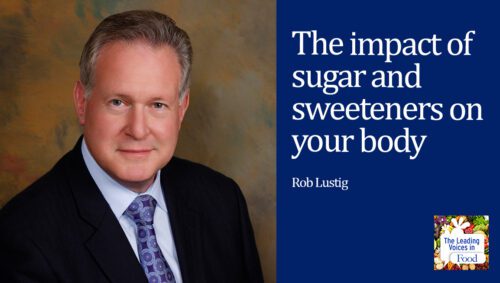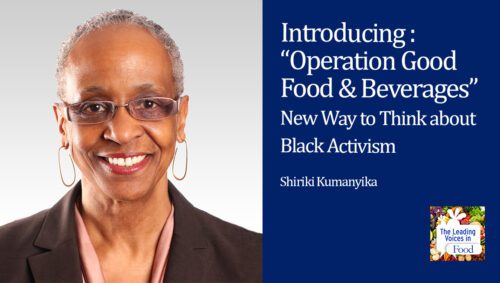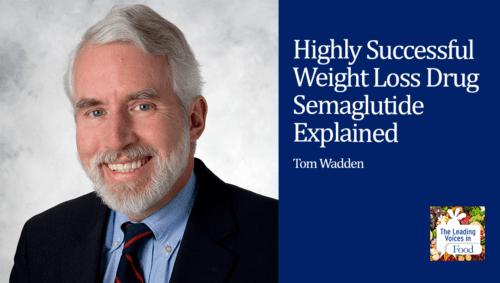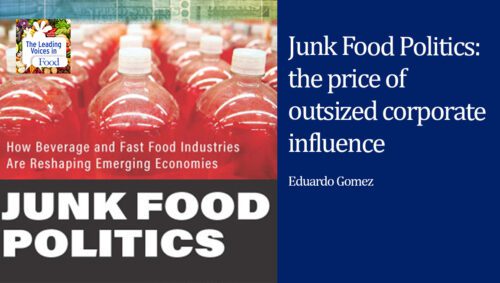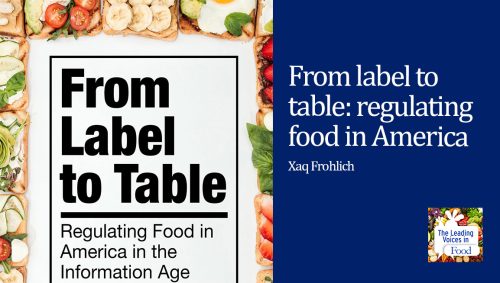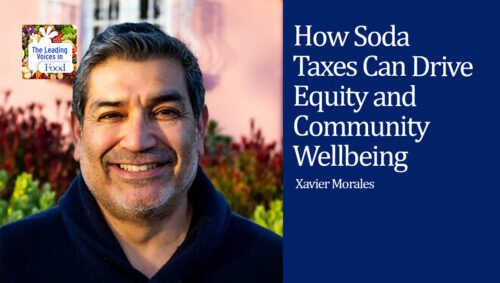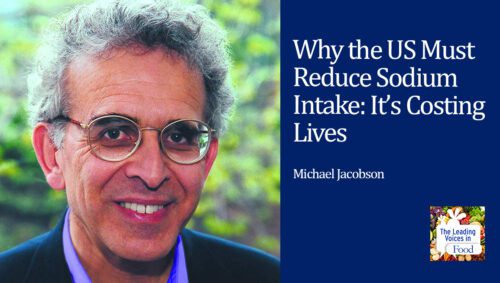The Leading Voices in Food
E150: What Food Policy Advocates Can Learn from Tobacco Industry Strategies
This is “The Leading Voices in Food” podcast but today we’re speaking with a leading voice in tobacco control. “How come,” you might ask, “why?” So I believe for many years that the parallels between the tobacco industry and food industry practices are nothing short of stunning, and that our field would do very well to learn lessons learned from the pioneers in the tobacco wars. Our guest today is Dr. Kenneth Warner, Distinguished Emeritus Professor and former Dean of the School of Public Health at the University of Michigan. Ken’s research focuses on the economic and policy aspects of tobacco and health.
Subscribe: Apple Podcasts | TuneIN | Google Podcasts | SoundCloud | PocketCasts | Radio Public
Tags: Addiction & Food | Advocacy & Food | Food Policy | Soda Taxes | Ultra-processed Food & Additives |

Kenneth E. Warner is the Avedis Donabedian Distinguished University Professor Emeritus of Public Health and Dean Emeritus at the University of Michigan School of Public Health. A member of the faculty from 1972-2017, he served as Dean from 2005-2010. Presented in over 275 professional publications, Dr. Warner’s research has focused on economic and policy aspects of tobacco and health. Dr. Warner served as the World Bank’s representative to negotiations on the Framework Convention on Tobacco Control, WHO’s first global health treaty. He also served as the Senior Scientific Editor of the 25th anniversary Surgeon General’s report on smoking and health. From 2004-2005 he was President of the Society for Research on Nicotine and Tobacco (SRNT). He currently serves on the FDA’s Tobacco Products Scientific Advisory Committee. In 1996 Dr. Warner was elected to the National Academy of Medicine. He is a recipient of the Surgeon General’s Medallion, the Luther Terry Award for Exemplary Achievement in Tobacco Control, and the Doll-Wynder Award from SRNT. Dr. Warner earned his AB from Dartmouth College and MPhil and PhD in economics from Yale University.
Interview Summary
So Ken, you and I have a long history, and I thought it might be instructive to mention just a little bit of it because you really helped shape some of the ways I think about addressing food policy. So I first became familiar with your work long before I met you in person, when I was teaching classes at Yale. I was assigning papers you wrote on tobacco control and I was especially interested in work that you’d done on tobacco taxes. It really gave me the idea of pushing ahead with food-related taxes. Then finally I got a chance to meet you in person at a meeting that was hosted by the first President George Bush in Kennebunkport, Maine, on cancer control. You and I got to talking about similarities between the tobacco industry behavior and the way the food industry was behaving. We were both struck by the similarities. That led us to write a paper together that was published in 2009 in “The Milbank Quarterly.” And I have to say, of all the papers I’ve published over my career, this was one of my favorites because I really enjoyed working with you. I learned a ton from it, and it really, I thought, made some very important points. And I’d just like to mention the title of that paper because it pretty much summarizes what it found. So the title was, “The Perils of Ignoring History: Big Tobacco Played Dirty and Millions Died. How Similar Is Big Food?” In my mind, the playbooks are still very similar, and that’s why it’s really interesting to talk to you today, get a little sense of what’s happening more recently, and importantly, think about what lessons are learned from tobacco control. I wanted to bring up one thing from that paper that I always found fascinating, which was the discussion about something called “The Frank Statement to Cigarette Smokers.” Could you describe what that was and what role you think it played in history?
Sure. Just to give you some context for it, the first two major papers that implicated smoking in lung cancer were published in major medical journals in 1950. In December of 1952 there was an article in the “Reader’s Digest,” which incidentally was the only major magazine that did not accept cigarette advertising, that was entitled, “Cancer by the Carton.” And this was the American public’s first real exposure to the risks associated with smoking, and it led to a two-year decline in cigarette smoking, a very sharp decline, something that was unprecedented in the history of the cigarette. Following that there was some research published on mice and cancer. And needless to say, the tobacco industry was getting pretty nervous about this. So the executives of all the major tobacco firms met in New York City in December of 1953, and they collaborated on what became a public relations strategy, which drove their behavior for many years thereafter. The first thing they did was to publish “A Frank Statement to Cigarette Smokers” in January of 1954. This “Frank Statement” was published in over 400 magazines and newspapers, and it reached an estimated audience of some 80 million Americans, which would be a very good percentage of all Americans in those years. And they talked about the fact that there was this evidence out there, but they said, “We feel it is in the public interest,” this is a quote, “to call attention to the fact that eminent doctors and research scientists have publicly questioned the claimed significance of this research.” Then they went on to say, and I quote again, “We accept an interest in people’s health as a basic responsibility, paramount to every other consideration in our business. We believe the products we make are not injurious to health and,” and this is the kicker, “we always have and always will cooperate closely with those whose task it is to safeguard the public health,” end quote. They went on to say that they would support research on smoking and health, and, of course, that they would always be the good guys in this story. This was designed as part of a strategy to obfuscate, to deceive the public, basically, to lie about what they already knew about the health hazards associated with smoking. And it was essentially a first very public step in a campaign that, one could argue, in many ways has persisted ever since, although, obviously, now the tobacco companies admit that they’re killing their customers and they admit that smoking causes cancer and heart disease and lung disease and so on. But that was kind of the beginning of the strategy that drove their behavior for decades.
You know, that was one of the issues we raised in our paper. How similar were the big food companies in talking about concern for the health of their customers, planting doubt with the science, pledging to make changes that were in the interest of public health, agreeing to collaborate with public health officials? All those things played out in the food arena as well. And that’s just one of many places where the food industry behave very, very similar to what the tobacco industry has done. But boy, is it interesting to hear that particular anecdote and to learn of the cynical behavior of the industry. So fast forward from there, and you think about the tobacco industry executives testifying before Congress that nicotine wasn’t addictive, and you have that same process playing out many years later. These similarities are really remarkable.
So let’s talk about your work and some of the issues that I think apply to the food area, and let’s talk about taxes at the beginning. So I worked for years on the issue of soda taxes, and these taxes now exist in more than 50 countries around the world and in a number of major cities in the US, including San Francisco, Philadelphia, Seattle, and Oakland. And these taxes have been shown to have really positive effects, and they seem to be growing around the world. And I’d like to understand what you see as the overall findings from the work on tobacco taxes. But before we do that, you have a very interesting story to tell about how the tobacco control community responded when you first began speaking about taxes. It turns out to be taxes on tobacco have had whopping effects. But what was the initial reaction to people in that field?
Yeah, it is kind of an interesting story. So around 1980, when I first started writing and talking about tobacco taxation as a method of reducing smoking, I used to have public health audiences booing me. If they had rotten tomatoes with them, they would have been throwing them.
You know, Ken, it’s hard to imagine because now these taxes are completely routine and accepted.
Yes, they’re not only routine and accepted, they are a first principle of tobacco control. They are enshrined in the World Health Organization’s Framework Convention on Tobacco Control. So they really are kind of the first thing we turn to because we know that they work. We know that they reduce smoking.
But let me give you a story about how I learned that this is not only a phenomenon with people smoking. It’s a phenomenon with people using all other drugs, and it turns out it’s a trans-species law, the Law of Demand. And that law says, basically, that if you increase price, the demand for the commodity will decrease. Well, in the beginning, the public health audiences believed two things. They believed that smokers were so addicted that they would not be affected by price, so it was ridiculous to even think about it. And they said, you have to have intrinsic motivators to get people to quit smoking. They have to care about their kids. They want to see their kids grow up, their spouses, and so on, and not extrinsic forces like a tax. So those were their two objections. So the story that I think is really kind of fun. I was on a plane flying to a small conference in Kansas City. This is sometime in the early ’80s. And I happened to be seated next to Jack Henningfield, who is probably the preeminent psychopharmacologist dealing with nicotine, maybe in the world. And we were talking about price response, the fact that cigarette taxes work. And he said, “You know, I’ve got something I want to show you here.” And he pulled out some what are called response cost curves from the psychology literature. And this is where you take a laboratory animal, in this instance addicted to narcotics or other addictive substances, and you give them a challenge to get their drugs. So first, I should note that these animals are so addicted that if they’re given the choice between food and their drug, they will choose their drug, and they will in fact end up dying because they place a preference for the drug over food. But it turns out that when you increase the price of the drug to them, they decrease the amount that they consume. So what do I mean by that? If they have to push a lever, a bar, a certain number of times to get a dose of their drug, and you raise the number of bar pushes per dose, they will dose themselves with fewer doses. I took a look at these curves, and basically, a response cost curve for these lab animals is essentially a demand curve as we economists see it. And I calculated the price elasticity of demand, which is our standard measure of the responsiveness to price. And it turns out that addicted laboratory rats have essentially the same price elasticity of demand, the same price responsiveness that human beings do to cigarettes.
That’s an absolutely fascinating story. And, you know, I know Jack, and have admired his work, as you have, and it’s amazing to think about that conversation on a plane, and what sort of scientific work it led to, and how that, in turn, found its way into policies that exist around the world. So tell us then about tobacco taxes, and how high do they have to be in order to affect consumption in an appreciable way, and have they worked in reducing tobacco use, and what’s your overall take on that?
So we have, quite literally, hundreds of studies in countries around the world, and we know a lot but we don’t know everything. So we don’t know, for example, if there’s a particular price above which, you know, nobody will use the product. We don’t have even really good data suggesting of, you know, what’s the minimum increase in price that you have to have to have a noticeable impact. Overall, the literature suggests that if you increase the price of cigarettes by 10%, you will decrease the quantity demanded by 3 to 4%. Now, what this means is that roughly half of that decreased demand reflects decreases in the number of cigarettes that continuing smokers use, while the other half represents decreases in smoking, people quitting or kids not starting. So the demand is what we call price inelastic. The price change itself is larger, proportionately, than the decrease in consumption. But that decrease in consumption is still substantial and it’s enough to have a large impact.
Now, cigarette prices vary all over the world, and cigarette prices vary primarily because of taxation differences. So if you go to the Scandinavian countries, you’ll find that a pack of cigarettes will run $15 or more. If you go to Australia, you’re looking at $30 or more a pack. In the US, currently, we’re looking at an average price in the range of about 7 to $8. In some jurisdictions, like New York City, it’s $10 or more. But the prices in the US are actually relatively low among the more developed nations in the world. Any tax increase will have an impact but obviously the larger tax increases will have larger impacts. And there’s some good and bad news in tobacco taxation, particularly in a country like ours, and this is, again, true for most of the developed world. Smoking is now concentrated in marginalized populations. I’m talking about low socioeconomic groups, the LGBTQ community, and racial minorities, in particular. If you think of this as an economic phenomenon, when you raise the price on cigarettes, you’re going to hit the worst-off economically segments of the population hard. That’s the bad news. The good news is that those people, precisely because they are poor, tend to be much more price responsive than high-income smokers, and more of them will quit. So we have this problem that the tax is regressive, it imposes a larger burden on the poor, but the health effect is progressive. It will reduce the gap between the rich and poor in terms of smoking rates. And of great importance, there’s an enormous gap between the rich and poor in this country in life expectancy, and as much as half of that may be differences in smoking rates.
Ken, there’s a hundred follow-up questions I could ask, and I find this discussion absolutely fascinating. One thing that came into my mind was that some years ago I looked at the relationship of taxes, state by state in the US, and rates of disease like lung cancer and heart disease. And there was plenty of data because there was a huge range in tobacco taxes. Places like New York and Rhode Island had very high taxes, and the tobacco Southern states, like North Carolina, had very low taxes. But what’s the sort of recent take on that, and the relationship between taxes and actual disease?
Well, it’s still true. And there are, in fact, what you suggest, the southeastern block of tobacco states have unusually low rates of taxation. And I haven’t seen any recent data but one presumes that they are suffering more from smoking-related diseases because their smoking rates are higher. I mean, that has to be true. So I don’t know that we have any particularly good data recently, but there have been studies that clearly relate tobacco or cigarette prices to health outcomes associated with smoking.
I’m assuming US scientists have played a prominent role in producing the literature showing the negative health consequences of using cigarettes, and yet you said the United States has relatively low taxes compared to other developed countries. Why, do you think?
I think we’re going to get into a very philosophical discussion about the US right here. It has to do with individual responsibility. We know for sure that the initial reason the taxes were so low was that the tobacco block was so influential in the Senate, particularly in the days when Jesse Helms, the senator from North Carolina, was in the Senate. He was the most feared senator by the other senators, and if you wanted to get anything done for your cause, you had to go along with his cause, which was keeping cigarette prices low and doing everything they could to support smoking. So there’s clearly been a built-in bias in the Senate, and basically in the Congress as a whole, against tobacco policy. You see a huge variation from state to state in tobacco policies, and it’s reflective of basically their political leanings in general.
You brought up this issue of personal responsibility, and boy, does that apply in the food area. You know, the food companies are saying: if you have one sugar beverage every once in a while, it’s not going to be harmful. And it’s not use of the products but it is overuse of the products. Thereby saying, it’s not corporate responsibility we’re talking about here, it’s personal responsibility. That same argument was made by the tobacco industry, wasn’t it?
It was. They would be less inclined to do that today, for a couple of reasons. One is that we know that even low levels of smoking are harmful and indeed cause many of the diseases that we were referring to earlier. And I think all the companies have now admitted publicly that smoking does cause all of these diseases that we’ve long known it causes. And all of them are claiming that they would like to move away from a society with smoking to one that has alternative products that would give people choices and ways to get their nicotine without exposing themselves to so much risk. I mean, we have to remember, the fact that cigarettes kill their consumers is a real drawback as far as the industry is concerned because they’re losing a lot of their consumers, you know, 10, 20 years before they normally would, and they have to deal with all these lawsuits. So it’s unfortunate for them. Having said that, cigarettes are the goose that lays the golden egg. They cost very little to manufacture. The industry is sufficiently oligopolistic that the profits are enormous, and their profitability has continued even while smoking has dropped rather precipitously ever since the mid-1960s.
Is that because the markets outside the US have been growing?
They certainly have helped. Although now, and this is only true within the last few years, the aggregate cigarette sales in the world are declining. They’ve actually started dropping. So we were seeing a relatively stable situation as smoking decreased in the developed world and was rising in the developing world. The only place now where we’re seeing increases in smoking are areas in Africa, which, by the way, is the one place in the world where we might be able to forego the tobacco epidemic because smoking rates are still quite low in most of the countries, not all of them, and also parts of the Middle East. But elsewhere we’ve been seeing smoking declining all over the world. That doesn’t mean the profits have to drop because one thing that the companies can do, is, they can raise their prices. Now, if prices go up because of taxes that hurts the companies. But if they raise their own prices because demand is inelastic, what that means is that the percentage increase in the price is larger than the percentage decline in the demand for cigarettes. So they’re actually adding to their profitability by doing that. They’ve always played this very interesting game for years of keeping price below what we would think to be the profit-maximizing price. And I think the reason for that has to do with addiction because they know that they have to have what are called replacement smokers, kids coming in to take the place of the smokers who are dying or quitting. And for years, I think, they kept their prices down because they didn’t want to discourage young people from smoking. Now, I think they see the writing on the wall. Smoking is declining very rapidly. Smoking prevalence, which was 45% in the mid, early-1960s, is now a little over 12% in the US, and I think they’re raising their prices with the understanding that they want to take as much advantage of the opportunity with the addicted smokers, the adults, as they possibly can, even though smoking among kids is becoming vanishingly small.
I think of so many parallels with the soda taxes that now exists in a number of places, and the companies have responded somewhat differently. And perhaps it’s the level of addiction issue that kicks in here, and the need to have replacement customers. Maybe that’s another key difference. But with the soda taxes, the companies have not increased prices beyond the level of the tax. You know, to delight of public health experts, the companies have tended to pass along the entire tax so the companies are not eating that difference in order to keep prices the same. Higher tax gets reflected in the ultimate price that they charge, but they’re not increasing prices beyond that. Do you think it might be the addiction issue that’s different here?
I don’t know. I mean, that certainly could be an element of it. The other thing is that they’re manufacturing other drinks that are being used in place of some of the sodas. So they’ve got waters, they’ve got juices. I mean, obviously these sugary juices are no better, but they do make other products. They make the diet drinks. And to the extent that they can find substitutes for those products within their own companies, it may be that they’re content to allow people to make those substitutions.
Interesting comment. The results so far on the soda tax suggest that the most common substitution as people drink less soda, is water, which is of course better than a lot of the alternatives that people might be consuming, so that’s a bit of really good news. Even though the companies do sell water, Coke and Pepsi have Aquafina and Dasani, for example, they face a basic problem. Number one is that these companies are the biggest sellers of sugary beverages but not bottled water. That happens to be Nestle. So if people migrate to bottled water, they’re likely to migrate from the big companies, like Coke and Pepsi, to Nestle. Also, people tend not to be very brand-loyal to water. They tend to buy whatever is on sale or whatever they find available to them, and that creates a problem for these companies like Coke and Pepsi that do rely on brand loyalty for their marketing. So it’s very interesting. And also, I wonder, based on the research on food and addiction, if the companies don’t take a hit if people switch from full sugar beverages even to diet beverages that they might sell because there wouldn’t be as much addictive potential, and therefore the customers wouldn’t have to have as much just to keep the habit going. So it’s really interesting to think this through.
That’s certainly very plausible. The whole thing would also depend on the price elasticity of demand for sodas, and specifically for the brands that they’re concerned about. If there is greater elasticity there than what we observe for cigarettes, then raising those prices aren’t necessarily going to help them all that much.
You mentioned that the elasticity estimates for tobacco suggested that a 10% increase in price led to a 3 to 4% reduction in consumption, and the numbers are even more positive in the case of the sugar beverages, where if you get a 10%, 15% increase in price, you end up with 10, 15% reduction in consumption. So that’s good news in the food arena.
That’s good news but it also means that they can’t do as easily what the tobacco industry can do, which is to raise their prices and expect to see profits rise. Because if they’re losing as much in sales as they’re gaining in price, it’s no win.
So Ken, let’s talk about product formulation because you mentioned that earlier, and this is a really interesting issue that, again, connects tobacco and food products. So you think about the tobacco companies mainly selling cigarettes, but now there’s vaping, there’s cigarettes with things like menthol and other flavors, or low-fat foods, or artificial sweeteners. The list of product reformulations in order to attract customers goes on and on and on. So I know a controversial topic in your field has been e-cigarettes. Can you explain what these are?
E-cigarettes have been around now for about a decade, let’s say. Basically, they’re devices that allow people to inhale nicotine and other substances, but the purpose is to give them their nicotine without combustion. And we know that the major problem associated with smoking is the products of combustion. There’s 7,000 chemical compounds in cigarette smoke. 70 of them are known human carcinogens, causes of cancer in humans. Many of them are cardiotoxic. They cause lung disease and so on. The e-cigarettes have about two orders of magnitude fewer toxins in their emissions than do cigarettes. And it turns out that the amount of the comparable toxins, when they are in fact comparable, that you find in the e-cigarette emissions is much lower, usually a 10th to a 400th, of what you find in cigarette smoke.
So logically, and based on a fair body of evidence at this point, vaping, use of e-cigarettes to get nicotine, is substantially less dangerous than is cigarette smoking. However, the controversy here is incredible. This is the most divisive issue that I have witnessed in my 45 years of working in the tobacco control field. It has torn the field asunder. The mainstream of public health, and by that I’m including governmental agencies, the Campaign for Tobacco-Free Kids, the Truth Initiative, the American Cancer Society, heart and lung associations, all of mainstream public health is strongly opposed to e-cigarettes, and for one reason. They’re concerned about kids’ uptake of e-cigarettes, which has been substantial. It’s been decreasing the last couple of years, but it has been substantial. And there are a number of things they’re concerned about in that regard, and they’re completely ignoring the fact that there’s pretty good evidence that e-cigarettes are increasing smoking cessation for a subset of smokers. And a number of us on the science side of this, believe that the net effect of e-cigarettes is beneficial, that it’s actually, possibly, a tool to add to the armamentarium of things like cigarette taxation, like smoke-free workplaces, like restrictions on advertising, and that it will help a group of inveterate smokers, those who either can’t quit nicotine or don’t want to, to move to a less dangerous alternative to smoking. I am not saying that e-cigarettes have no risk associated with them. They almost certainly do. But it is substantially lower.
Now, historically, this is divisive within the field in part because all of the earlier attempts at, quote-unquote, tobacco harm reduction have been produced by the major cigarette companies, and they’ve been fraudulent. So cigarette filters were manufactured and sold, starting in the 1950s, in response to the scare that I referred to earlier about cancer. And they were sold with a message that the filters block the dangerous stuff but let the flavor through. And people bought this. That decrease in smoking in the early 1950s reversed, smoking went up sharply, as sales of filtered cigarettes went up. By the way, the first successful filtered cigarette was Kent, and it used what it referred to as the miracle Micronite filter. Well, that miracle Micronite filter turns out to have been made of asbestos. And there are lawsuits continuing to the present day by workers in the factories that made the filter tips for Kent cigarettes, who themselves ended up with lung cancer or other diseases due to the asbestos. Then came low-tar and nicotine cigarettes, and we actually have ample evidence from the documents that had been revealed by lawsuits, that the industry knew that this was a public relations device. It was not a harm reduction device. And in fact, because people believed that low-tar and nicotine cigarettes were less dangerous, it’s likely that it actually increased the toll of smoking because people who would have quit, switched to low-tar and nicotine cigarettes instead. So there’s some pretty awful history here that makes people legitimately concerned about alternative products. A critical element of this story is that the alternative products, in this case, the e-cigarettes were introduced by non-cigarette, non-tobacco companies, and their goal was to replace smoking. Now the major companies are all making their own e-cigarettes as well because they have to do it from a defensive point of view, but basically they don’t have any great interest in slowing up the sale of cigarettes. They want to benefit from that as long as they can.
So I should know the answer to this but I don’t, but are e-cigarettes taxed? And wouldn’t it be optimal to tax e-cigarettes but less than regular cigarettes so you discourage use of both but discourage the use of regular cigarettes more?
That is very insightful. Two colleagues and I actually published a paper saying that in 2015 in “The New England Journal of Medicine,” that we should be taxing e-cigarettes modestly, the reason being that we want to discourage kids from using them, and kids are far more price-sensitive than our adults. Kids have a very elastic response to cigarette prices. Adults do not, and in particular, older adults have even lower price responsiveness. So yes, there should be some taxation of e-cigarettes to discourage youth use of it but that taxation should be dramatically lower than the taxation of cigarettes. Some states are now taxing e-cigarettes. Not all of them. The federal government is actually looking into a proposal to double the tax, the federal tax, on cigarettes, which would take it up to $2.01 a pack, and at the same time, to establish an equivalent tax, similar to the $2 tax, on all vaping products. This would be a disaster because it would definitely discourage kids from vaping, but it would also discourage adults from using e-cigarettes as an alternative to smoking, and the most addicted, the inveterate smokers, those are the ones that need these alternatives. So that’s a bad policy proposal. A much better one would be to increase the cigarette tax by more than a dollar, raise it to 3 or $4 or something, and impose a modest tax on e-cigarettes. This would discourage people from smoking, both adults and kids, but especially kids. It would discourage kids from using e-cigarettes but it would create a price differential that would encourage the inveterate smokers to switch to e-cigarettes. Now, part of the problem, and this has gotten worse over time, is that the American public believes that e-cigarettes, that vaping, is as dangerous and even maybe more dangerous than cigarette smoking. Nothing could be further from the truth but so far the mainstream of public health has sold that message to the public, and the public, including smokers, believe it.
That’s a fascinating story about how the public health field might be getting in its own way with this.
And maybe doing damage to public health.
So let’s loop back a little bit to the behavior of the tobacco industry. So in 2017, the Phillip Morris Company funded and launched an organization called Foundation for a Smoke-Free World. So I think, hmm, a tobacco company saying they want less smoking, and one could view this with pretty high cynicism but what do you think about it?
I’ve always shared your sense of cynicism about it. There’s an interesting anecdote related to this. The individual who negotiated the deal by which Phillip Morris offered $1 billion over a 12-year period to establish this foundation, that individual was the main actor in the World Health Organization during the development of the global treaty on tobacco control, the Framework Convention on Tobacco Control. He also became director of the organization and served in that capacity until just the other day. He has stepped down from being director. But let me give you a little context for it. Philip Morris International that needs to be distinguished from Altria and Philip Morris Domestic, but Philip Morris International sells the leading brand of what is known as heated tobacco products, HTPs. These are products that actually have tobacco in them. E-cigarettes have no tobacco in them but these products actually have tobacco in them. But instead of burning the tobacco, they heat it. They volatilize it, and the nicotine is inhaled. Like e-cigarettes, they appear to be substantially less dangerous than smoking, although it’s not clear that they’re as less dangerous as, than, e-cigarettes. But they’re produced only by the major cigarette companies. Philip Morris is now selling these products successfully in many countries, many cities around the world. While they actually have the authorization to sell an older version of the product in the US, it’s not very popular at this point. But in Japan, over the last four years there’s been a drop in cigarettes sold of about a third at the same time that there’s been this great increase in the use of these heated tobacco products manufactured by Philip Morris International and by Japan Tobacco. They have a product called Ploom. Philip Morris’ product is called IQOS, I-Q-O-S, which, I was told, originally stood for I Quit Ordinary Smoking. So they are the leader of the theme song that the industry is singing these days about how they want a smoke-free world and they want to move toward one. But the only way they’re ever going to do that, willingly, is if they can sell other products like these heated tobacco products and make large sums of money on them. Philip Morris has a good start at that. They claim that about a third of their revenue now is coming from IQOS, this heated tobacco product.
So whether that foundation ultimately has beneficial effects or not, forget corporate beneficial effects but on the public good, would pretty much depend on who’s choosing to use these e-cigarettes, I’m imagining. That if it’s people switching from normal cigarettes to them, or using them instead of normal cigarettes, it’s one thing. But if they’re recruiting new people who otherwise wouldn’t smoke, then it would be a bad thing. So how do you think that’ll all play out?
That’s actually a critically important question, Kelly. And one of the great concerns that the opposition to e-cigarettes has, is that they’re addicting lots of kids to nicotine, and that many of them will go on to smoke, and that that will reverse the progress that we made on smoking. Now, it turns out that there is no evidence to support the latter contention. And in fact, there’s evidence to the contrary. I think it’s entirely possible that some kids who would not have touched a cigarette otherwise are vaping and then trying cigarettes in the future. Whether they become regular smokers, remains to be seen. But I think there certainly are some kids like that. But what we do know is that the rate of smoking among kids, what we call current smoking, and smoking among kids means that they’ve had at least one puff on a cigarette in the last 30 days, that number has plummeted over the last quarter century, and, and this is the interesting thing, it has gone down at its fastest rate precisely during the period in which vaping has been popular among kids.
So one theory is that vaping is displacing smoking to some extent. That kids who would’ve smoked are vaping instead. It’s a very complicated area and we don’t know the answer. Among adults who vape, and they are relatively few in number except for very young adults, we observe mostly dual use, but the question is how much of this is a transition to vaping only, and then, maybe, a transition to nothing after that. In the UK, where vaping has been advertised by the health organizations as a way to quit smoking, and they have encouraged its use, and they use it in their smoking cessation clinics, and you’ll even find it in hospitals, in the UK we have seen that more than half of the people who have quit smoking by using e-cigarettes have also quit vaping. So it is no longer the case in the UK that a majority of the people who vape are also currently smoking.
In the US, the data have been moving in that direction but it’s still a majority who are dual users rather than vaping only. But we have evidence of four or five completely different kinds of studies, commercial data, other products in other countries, that all lead to the conclusion that vaping is already increasing the rate of smoking cessation in the US and in the UK by probably 10 to 15%. That’s a hard thing to see in the data but it is something that, if you dig into the data, you will see it, and as I say, we see it all over the place. Let me give you one example of the tobacco harm reduction story that’s fabulous. 40 to 50 years ago, large numbers of Swedish males started using a smokeless tobacco product called snus, S-N-U-S. It’s a relatively low nitrosamine product, nitrosamine being a carcinogenic element, and they substituted it for cigarettes largely because cigarette taxes were going way up and there weren’t any significant taxes on snus. So what you observe today, some three, four decades or more later, is that Swedish males have the lowest male smoking rate of any country in Europe, and maybe in the world. They do not have a low tobacco use rate. Their tobacco use rate is pretty typical but it consists mostly of snus. And they also have by far the lowest rate of tobacco-related diseases, like lung cancer, of men in all of the European Union countries, and the second lowest is typically a rate twice or more that of what you see in the Swedish males. Swedish females, who did not quit smoking in large numbers and did not take up snus until fairly recently, have rates of lung cancer and other diseases that are average or above-average for the European Union. So that’s a great example of tobacco harm reduction in action, and it’s one that’s been around now, as I say, for decades.
Ken, this is a remarkable history and you’re just bringing it alive beautifully. But let me ask you one final question. So given that you’ve been working in this field for more than four decades now, and have really been a pioneer, a leader, a warrior, and a hero, all those things could be applied to you and your work, if I asked you to sum up what’s been learned from all these decades of work on tobacco, what would you say?
There are a lot of lesson. Certainly, we have learned specific kinds of interventions that really matter. You and I spoke about tax at some length. That’s the preeminent one. Smoke-free workplaces, including smoke-free restaurants and bars, have not only themselves had a direct impact on health but have also set the tone for a more smoke-free society. So we have seen quite dramatic changes. I mentioned we’re going from a 45% rate of smoking for the nation as a whole down to a little over 12%. That, however, has taken us six to seven decades. So it’s kind of a good news, bad news story. It’s a very complicated area. Tobacco control was ranked by CDC as one of the 10 most important public health measures of the 20th century, and also the first decade of the 21st century. And I think that’s completely legitimate, and it is something about which all of us who care about public health can feel very proud about. The problem still remains. It is an enormous problem, as you alluded earlier, in many parts of the developing world, the low- and middle-income countries, and it’s a growing problem in some of those countries, and it’s just not going to disappear real fast. The lesson that I’ve taken most recently has been a discouraging one, and that’s how divisive our field has become. We really have a chasm between the people who are opposed to tobacco harm reduction and those who are supportive of it. They’re good people on both sides, they believe what they’re saying, but they can’t talk to each other civilly at this point. I hope that that will not become the case for those of you who are fighting the good fight in dealing with unhealthy foods.

